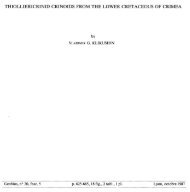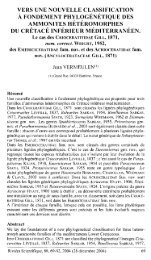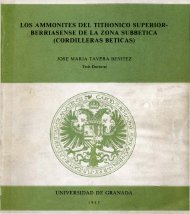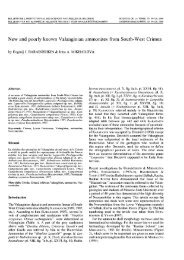peter franklin rawson, dennis curry, frank charles dilley, john michael ...
peter franklin rawson, dennis curry, frank charles dilley, john michael ...
peter franklin rawson, dennis curry, frank charles dilley, john michael ...
You also want an ePaper? Increase the reach of your titles
YUMPU automatically turns print PDFs into web optimized ePapers that Google loves.
marine Lower Cretaceous is developed in a variety of clastic facies, many of whichcontain ammonites: as the Lower Cretaceous stages are in effect defined by theirammonite zones correlation can be attempted with some confidence even thoughsome of the ‘standard’ zones are established on Tethyan faunas. Hence the stageterms have long been familiar in the British literature, though their usage has variedconsiderably.The Upper Cretaceous presents greater problems: “Upper Cretaceous” issynonymous with the Chalk over most of the British Isles, though non-chalkmarginal facies of Cenomanian age are present in south-west England, NorthernIreland and western Scotland, and in some parts of Northern Ireland the non-Chalkfacies extends up to the Campanian.The classic division of the Chalk has been into Lower, Middle and Upper: thebase of the Middle Chalk is marked by the Melbourn Rock (a complex of nodularchalks and incipient hardgrounds) and the base of the Upper Chalk by the ChalkRock (a composite hardground). Where the Chalk Rock is absent, as in Yorkshireand Lincolnshire, even this lithological division becomes uncertain and perhapsshould not be maintained. After the work of Barrois (1876) it was recognized that itwas easier to divide the Chalk by its beautiful fossils. In the finer and finersubdivisioris that were gradually distinguished, the relations between lithologies andfaunas were nearly overlooked. When standard stage names came to be used inBritain, in several cases not until the middle of this century, they were fitted into apre-existing local zonal scheme. This was ill-defined, and zonal limits were oftenmore influenced by facies than its authors, such as Rowe (1900-1908), had recognized;in several cases stage boundaries have been equated with changes of lithology.(ii) The zonesThe zones used in the British Cretaceous have been set up empirically, and usedwithout regard to which theoretical type of zone they may be. In theory most areassemblage zones, including the majority of the Ryazanian to Cenomanian ammonitezones. Some of the ammonite zones are based on an evolutionary lineage, e.g.the Endemoceras zones of the Lower Hauterivian; in some cases the range of theindex species coincides with the limits of the zone, e.g. Euhoplites lautus; in othersthe index species is not known through the whole of the zone named after it, e.g.Leymeriella tardefurcata; in yet others the index species ranges outside its own zone,e.g. Calycoceras naviculare.In the Turonian to Maastrichtian (Middle and Upper Chalk), problems arise fromthe scarcity or absence of organisms which originally had aragonitic shells, except atcertain levels such as the Chalk Rock. For instance, only two ammonites (bothtexanitids) are known from the Santonian. Yet aptychi occur widely, and the greatrarity of ammonites and other aragonitic shells may be the result of sea-floordissolution. Most Chalk zones are of relatively long duration (l-4m a. y.); some areassemblage zones in which the presence or absence of the index species has littlemeaning, e.g. Zone of Terebratulina lata; others are absolute-range zones, e.g.Zones of Uintacrinus socialis and Marsupites testudinarius; and a few were intended
















